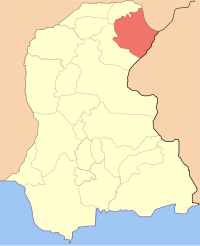District Ghotki
|
Ghotki District ضِلعو گھوٽڪي |
|
|---|---|
| District | |
 Ghotki is located in the north east of Sindh. |
|
| Coordinates: 27°49′N 69°39′E / 27.817°N 69.650°ECoordinates: 27°49′N 69°39′E / 27.817°N 69.650°E | |
| Country | Pakistan |
| Province | Sindh |
| Capital | Ghotki City |
| Area | |
| • Total | 6,083 km2 (2,349 sq mi) |
| Population (2017) | |
| • Total | 1,646,318 |
| • Density | 270/km2 (700/sq mi) |
| Time zone | PST (UTC+5) |
| Website | www |
Ghotki District (Sindhi: ضِلعو گھوٽڪي) (Urdu: ضلع گھوٹکی) is a district in Pakistan, located in the Sindh province. Its capital city is Ghotki City. Prior to its establishment as a district in 1983, it formed part of Sukkur District. According to the 1998 census, the district had a population of 970,550. Of these residents, 158,500 (16.33%) lived in urban areas, and 812,050 (83.67%) lived in rural areas.
The Ghotki district is administratively subdivided into the following Tehsils:
Khambhra city
The Ghotki District is a border district between the northern Sindh province of Pakistan and Punjab, Pakistan.
Ghotki is an industrial area in the Sindh province. Local companies based in Ghotki include OGDCL, Engro Fertilizers, Fauji fo Fertilizers (formerly Pak Saudi Fertilizer), TNB Liberty Power Plant, EngroPowergen PowerPlant, and Dosan Power Plant. Ghotki also has three gas fields: the Mari Gas Field, Qadirpur Gas Field, and Rehmat Gas Field.
Cotton is one of the district's major crops, with forty cotton-ginning factories in Ghotki. Another valuable crop is sugar cane. Four sugar mills are located in the Ghotki District: JDW Sugar Mills-3, SGM Sugar Mills, Daherki Sugar Mills, and Reti Sugar Mills.
The region is also famous for its mangoes, vegetables, and abundance of date trees.
According to the 1998 census results, the major first languages spoken in the district were Sindhi (92%), Urdu (3.1%) and Punjabi (2.9%).
Per the 1998 census of Pakistan, the most common religions in the Ghotki District are:
Also according to the census, the district's Hindus, Christians, and Urdu-speaking Muslims are mainly concentrated in the urban areas.
...
Wikipedia
